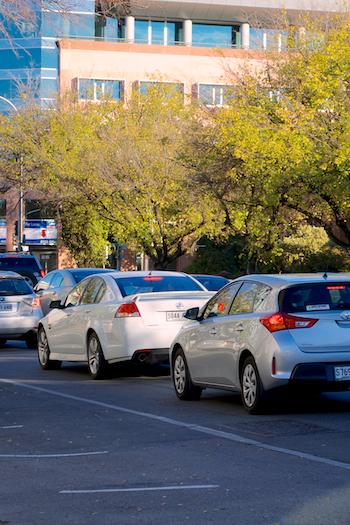What car is that?
Duration/age

Next time you are out and about with your child take notice of the different cars that you see. Talk about the colour, how many doors the car has, the numbers on the numberplate, or the size of the car.
That car has round headlights, but the small green one has square ones.
Sometimes you could make predictions about what you will see before you set off. Later on, you can compare to see who was right or had the closest guess.
I think we will see more red cars than green ones today.
Your child might have a favourite type or brand of car. When you are out and about how many models of your child's favourite brand you can see? Can your child identify what is different between each model or do you need to point the differences out?
The numberplate is not in the middle on the back like the others.
Sometimes you might just want to see if you can find another car that looks the same as yours.
They’re in the same car as us!
Skills this activity improves
Why does this matter?
Pointing out the differences in cars helps children to develop observation skills. When children are able to notice differences and changes they are able to use this information to sort and group. Sorting and grouping is the beginning of classification. “This is a 2 door model. That one is a 4 door model”.
As children refine their observation skills they begin to notice small differences between things. Noticing small differences is important for reading and writing. When children are not able to notice small differences they are not able to distinguish between “c and o” or “m and n” or “p and q”.
Talking about the differences your child has noticed between makes and models of cars helps them to develop a rich vocabulary. Having a rich and expanded vocabulary enables them to develop reading skills and to talk with a broader group of people. The development of a rich vocabulary is an important basis for social interaction and the development of friendships.
What does this lead to?
The development of a rich vocabulary and keen observational skills helps children to become fluent readers. When they are able to quickly see the differences in letters they do not need to stop and work out each letter within the word but will begin to read the word as a whole. Once they are able to read the word as a whole or to recognise and remember the word from sight they increase the speed and comprehension of their reading. This helps them to gain meaning from a sentence.
Learning how to sort, group and classify helps children to problem-solve and understand how to interact with objects. Classification helps them to understand the rules of how to interact with something.
Language to use
- Red, yellow, green, orange, black, grey, silver, blue, pink, white
- Light, dark
- Shiny, dull, gloss, metallic, flat, matt
- Door, numberplate, headlight, roof rack, bull bar, boot
- Brand, model, type
- 4WD, four wheel drive, family car, sports car, station wagon, sedan, truck, bus, fire-engine, garbage truck, limousine, police car, ambulance
- Large, small, medium
- Front, rear, back, side, top
Questions to use
- Do all cars have numberplates?
- Which colour car are there more of?
- Why do some cars have 2 doors and others have 4?
- What is the bumper bar for?
- Where do you put the shopping if you don’t have a boot?
- Would you take an ambulance to the shops?
Useful tips
- You might also like to take a look at the activities Building a car and Working at the car wash.
- If your child is younger, you can begin by comparing cars that are different to your family's car.
- Remember to talk to your child in your home language.
More ideas
- Make a lotto or bingo card to take with you. Your child can mark the cars off as you see them.
- Make a book about the different cars you see.
Variation by age
Birth to two year olds
- Sort all of your child’s toy cars into groups of colours.
- Borrow books from the library about cars.
- Play I-spy games.
- Take photos of cars you see and make them into a storybook.
Three to five year olds
- Sort all of your child’s toy cars into groups of colours.
- Borrow books from the library about cars.
- Play I-spy games.
- Take photos of cars you see and make them into a storybook.
- Explore the car section of the paper together.
Questions to ask
- Can you show me the big car?
- Which one is like our car?
- Where is the red car?
- Where do you sit?
Questions to ask
- Are all headlights the same shape?
- What colour is the most popular for cars?
- What makes the car go?
- Do all cars have the same number of wheels?
- Why do cars have a numberplate?
Language to use
- Big, little, small, large
- Red, blue, green, yellow, black, white
- Seat, door, lights, numberplate, keys
Language to use
- Wheel, numberplate, engine, petrol, headlights
- Shape, colour, size


